What was at the ISE-2017 exhibition (displays, LEDs, software for screens)
Every year the largest exhibition of the hemisphere is held in Amsterdam, within which various multimedia solutions and everything connected with them are demonstrated. We traditionally attend this event - we walk both in the common space and in closed sections for integrators, where you cannot shoot and record video. Below I will tell you what trends in the integration of all these pieces have appeared in a year.
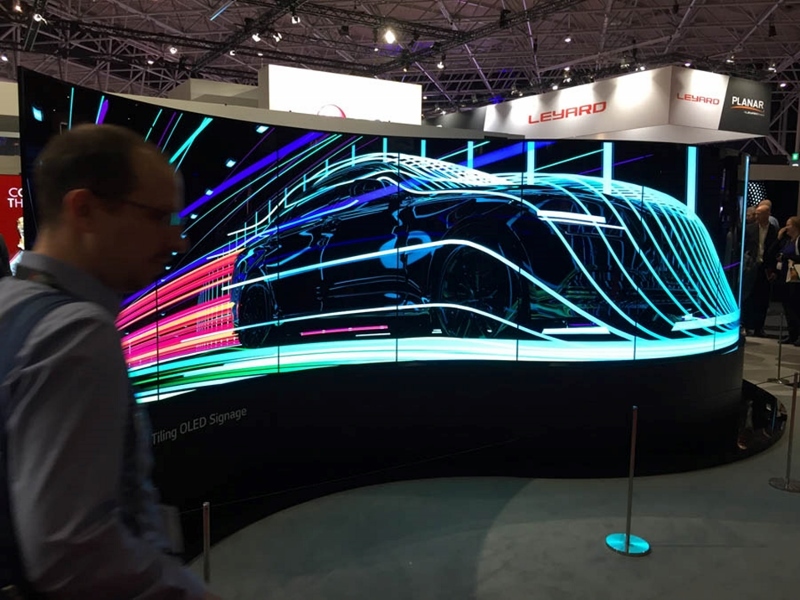
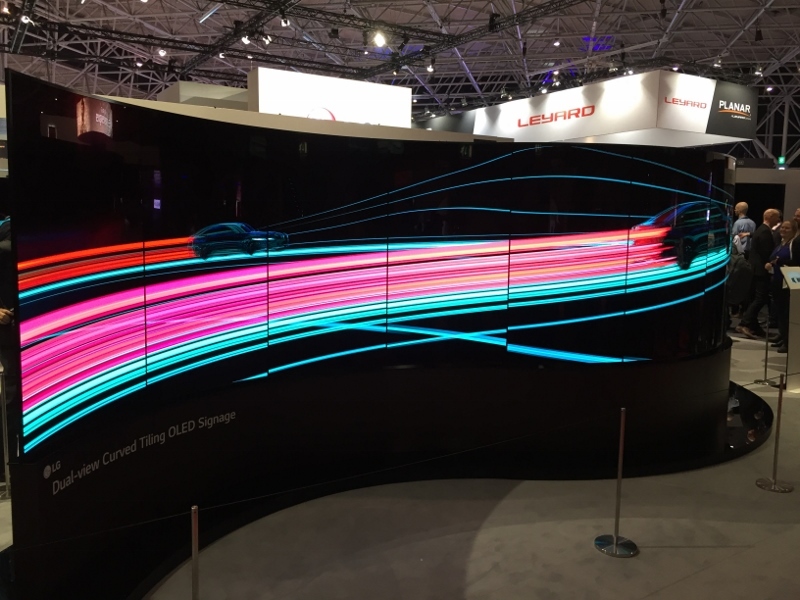
Two-way video wall (single screen) LG on OLED technology
Briefly about the most important thing:
')
1. LED screens are being improved, their production is cheaper. Accordingly, they are becoming more popular. The pixel pitch is already close to the psychological mark - 1 mm. Screens assembled from such modules have a juicy and bright picture at the level of top LCD panels. Technological processes for mass production of what was fiction 3-4 years ago, have already been honed and perfected. These screens can be used both for streets and for indoor use, for example, for information purposes. For retail they will also be useful, including external (front) advertising. Their advantage is brightness. With a certain technical performance, they are not afraid of weather conditions: neither sunlight, nor rain, nor cold.
2. Chinese manufacturers (in general, there are thousands of them, but LightLink, LightKing, Absen, Mignimage, Unilumin were remembered) tightly capture a multimedia niche. If, to my senses, before the exhibition was about 30% of the stands, now all 60%. From the breakthrough technology stage, we go to the butt stage, where engineers and developers are important. And there are more qualified engineers in China, thanks to their education system, which partially grew out of the Soviet one, than anywhere else.
3. Professional displays on OLED and QLED technologies are demonstrated.
4. There are many interesting software developments for the B2B sector.
This time, there was almost no unusual innovation at the exhibition, except for the closed area of the Samsung stand, where they showed screens on quantum dots.
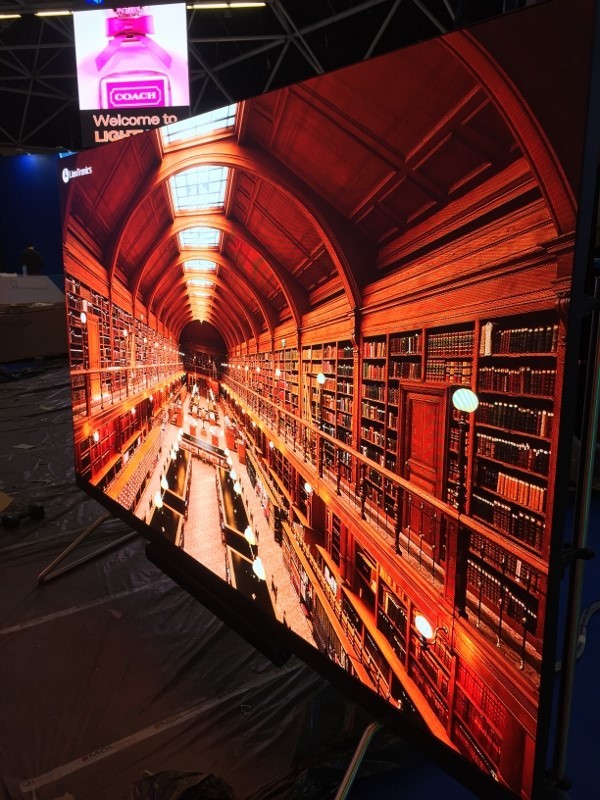

LED screen of another Chinese manufacturer. Juicy picture and simple assembly - what else do you need for happiness?
Each of the manufacturers competes not only in technology, but also in the entertainment of the exhibition stand. This year, Panasonic, the annual show-stopper, gave a great performance to attract attention. The manufacturer used a bundle: software for mapping and the formation of a single image with their projectors. If someone still doesn’t know what is probably incredible in our time, mapping is anchoring the image to objects and dynamically changing it in space in accordance with the movement of objects. This year, Panasonic screwed tracking of moving objects out of the box and superimposed on them the desired picture, taking into account all promising and geometric distortions. For the inexperienced, it looks like a miracle, but we have been doing similar tasks in our virtual reality center for several years now, so we simply admired the speed of work.
In general, there is software that processes content. Projectors transfer the image to a stitched concave screen. On the stand goes a man who holds a small board. He does some manipulations, and in accordance with his movements, the content also moves, while always remaining on the board. And there are balls that also move around the speaker. They also projected content during the move.
Easier to show than to explain)
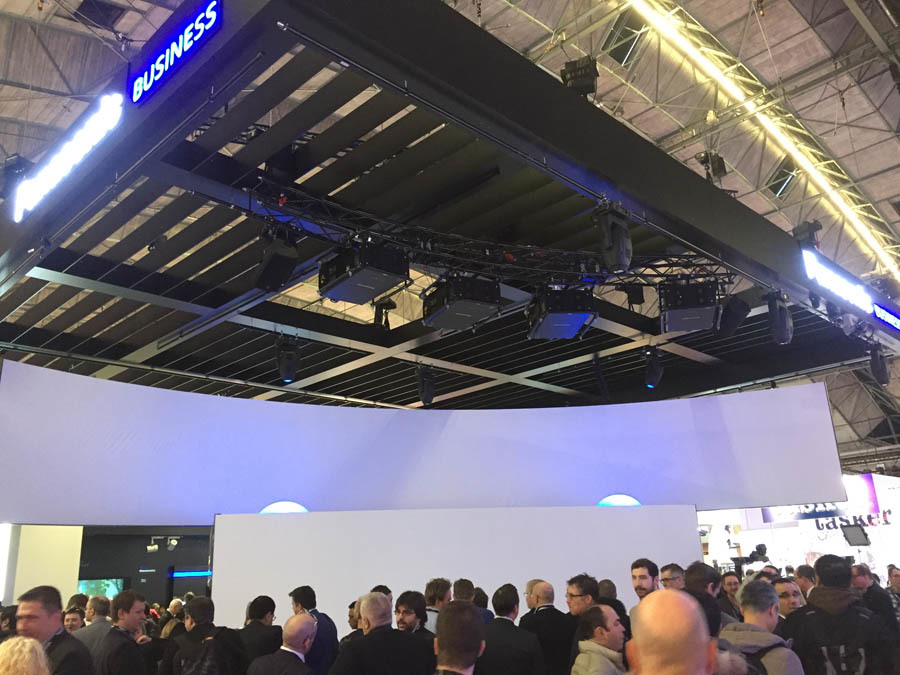
Here is their cluster of projectors.
Of course, no one will tell what kind of software they used, but Christie and Catalyst have similar solutions. In general, the exhibition had a lot of solutions related to content management: various types of screens and sensors, readers. But they all have their own, without a single holistic standard. The task is to combine everything into a single system.
This year, a noticeable change: a lot of LED screens of various types. Let me remind you that five years ago they were mainly used for outdoor advertising and were very expensive. Then they became weather-resistant, a little cheaper, they began to be used in indoor. Next, manufacturers have reduced the pixel pitch.
We see the final of the epic now - they are already in density, in my opinion, almost like LCD, but still much more expensive in terms of cost. The pixel pitch is smaller, which means such screens display content more accurately. If you place such a screen, for example, in a store, then in the commercial that is shown on it, you can look at everything to the smallest detail, even the texture of the fabric ... The images are more reliable.

LG Super Slim Screen
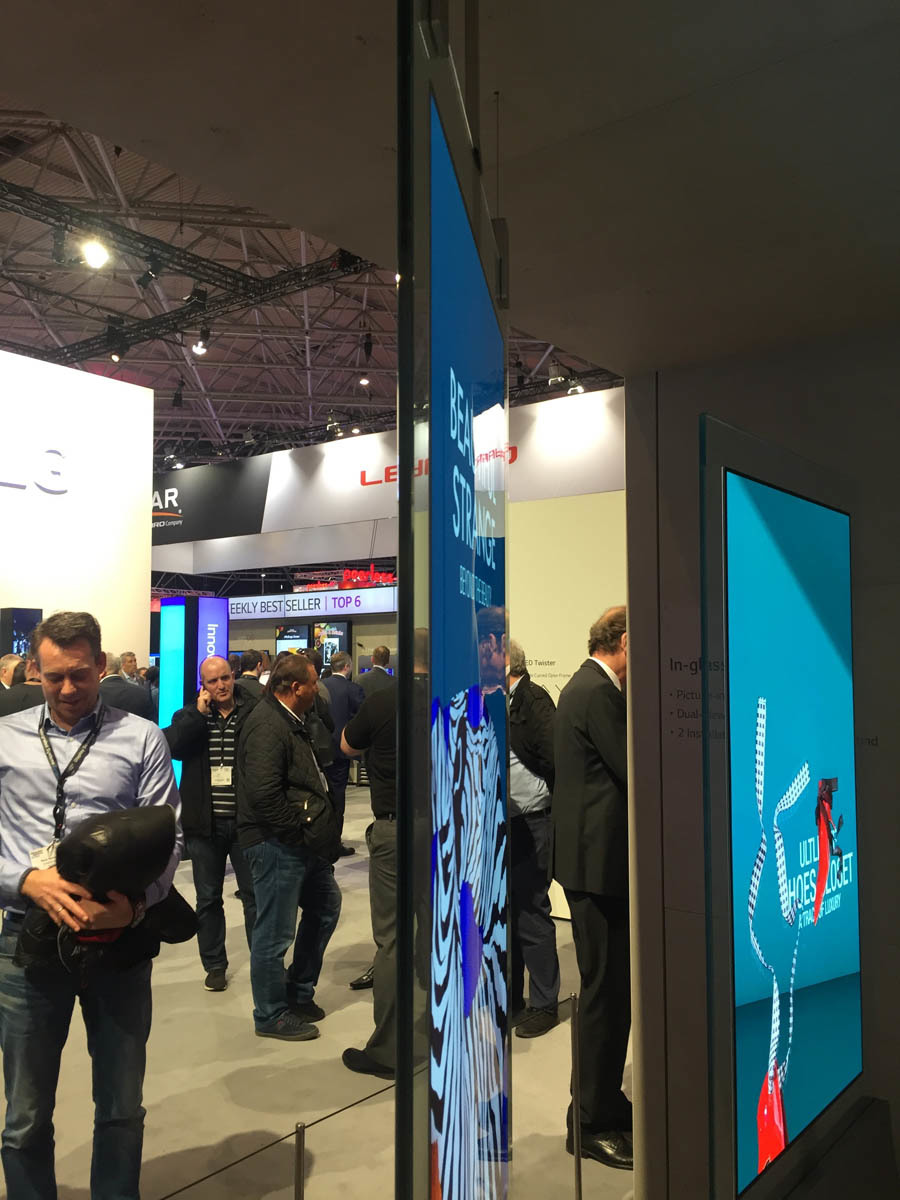
He is in turn
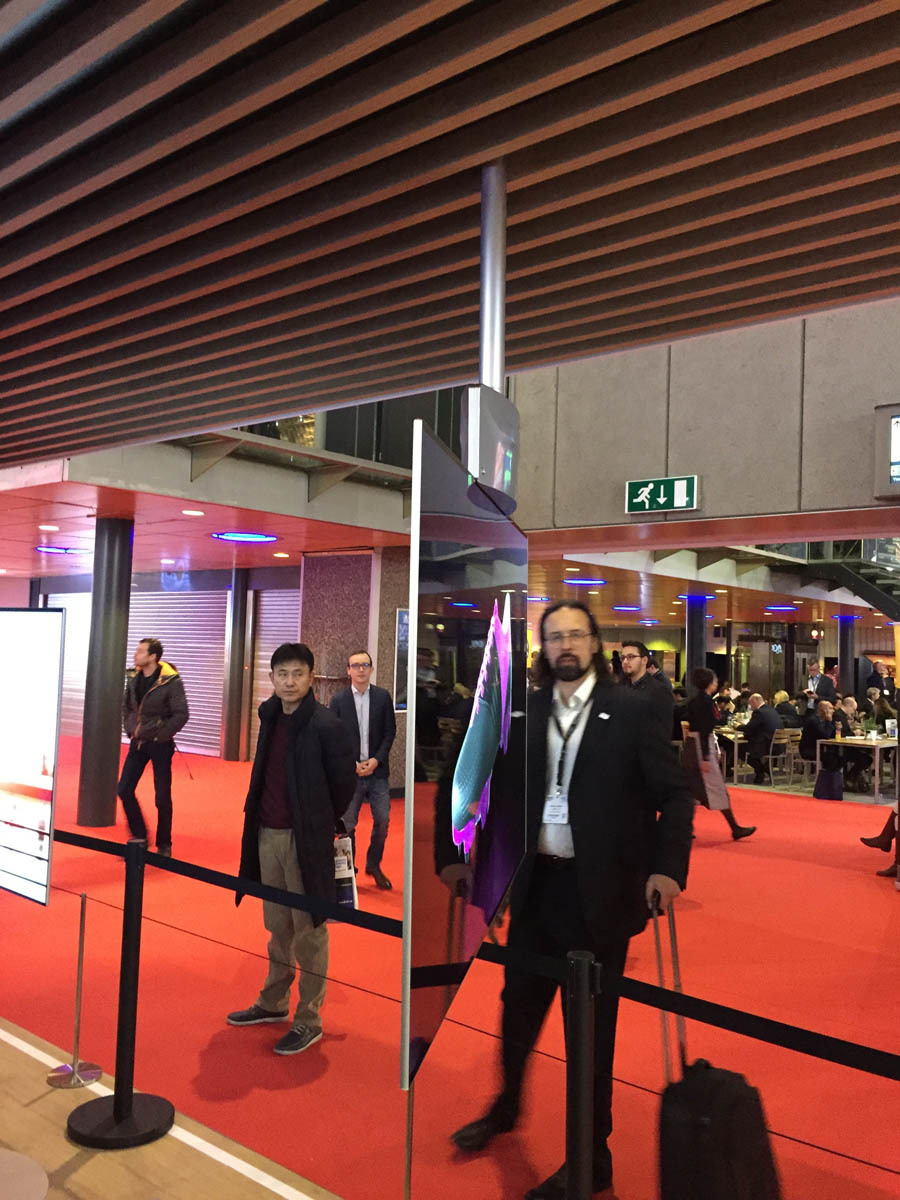
Two-way OLED-infotable
LG chose the OLED smartphones already familiar to us, and Samsung considered that the technological problems with the production of broad matrices are unworthy of attention, and immediately jumped onto a new technology - QLED, in other words, quantum dot displays. Here is a description of the technology .
Another trend is the simplification of screen connections. Previously, it was a real headache, but now the screens are interconnected very easily. Even a housewife can now assemble an unusual surface (I mean screens of irregular shape, disproportionate, with curved surfaces consisting of different parts). Well, at least, if she has only one higher technical, and not two, as before.
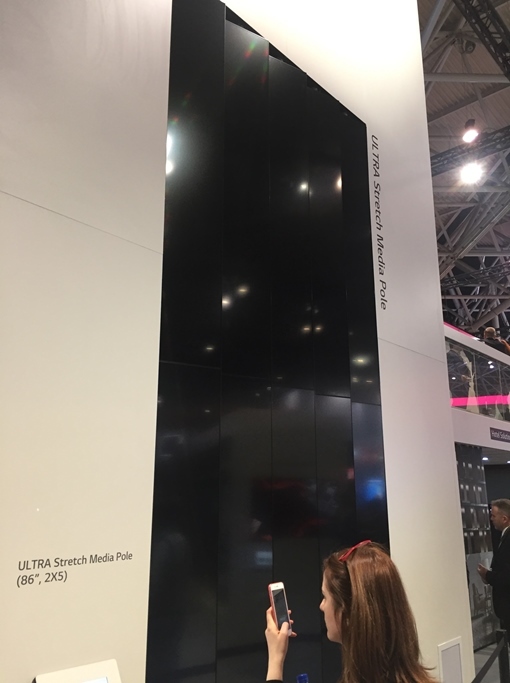
Here is just an example of an unusual surface - "blinds")
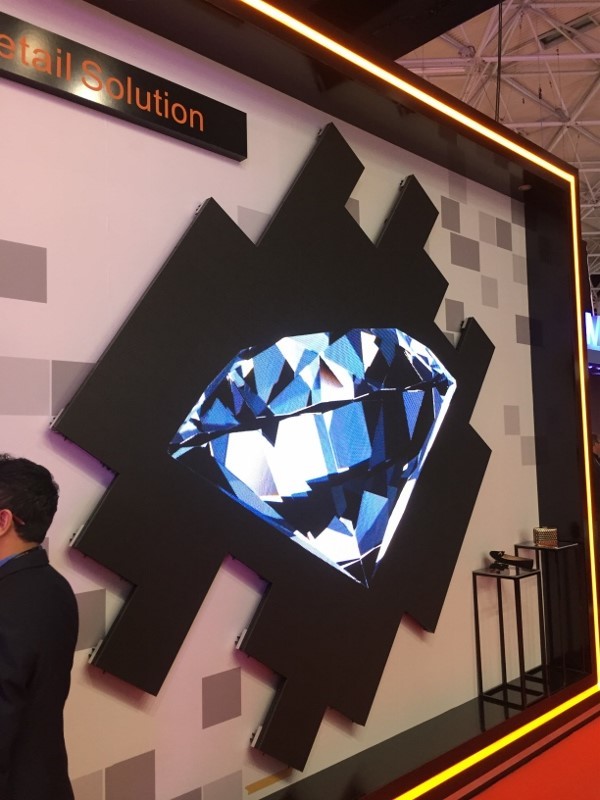
From individual screens you can even collect such
I was very pleased with the Mitsubishi stand - they made new cubes almost seamlessly. Previously, the seam was much larger than the pitch between the pixels, about 2 millimeters. Now there is less than one - it is very important for assembling large screens of control and situational centers. The fact is that they often show graphic materials with small elements (maps, engineering schemes, pipeline plans, nuclear station subsystems), and transmission without distortion is important there. Cubes are used because they are optimal for quickly understanding the situation, which is extremely important in emergency situations. LCD panels can give the same size of the assembly screen, but the seams will be larger. LED screens with a small pixel pitch are more expensive and are not yet as good in resolution. The result - most likely, such a wall will soon appear in our large control rooms:
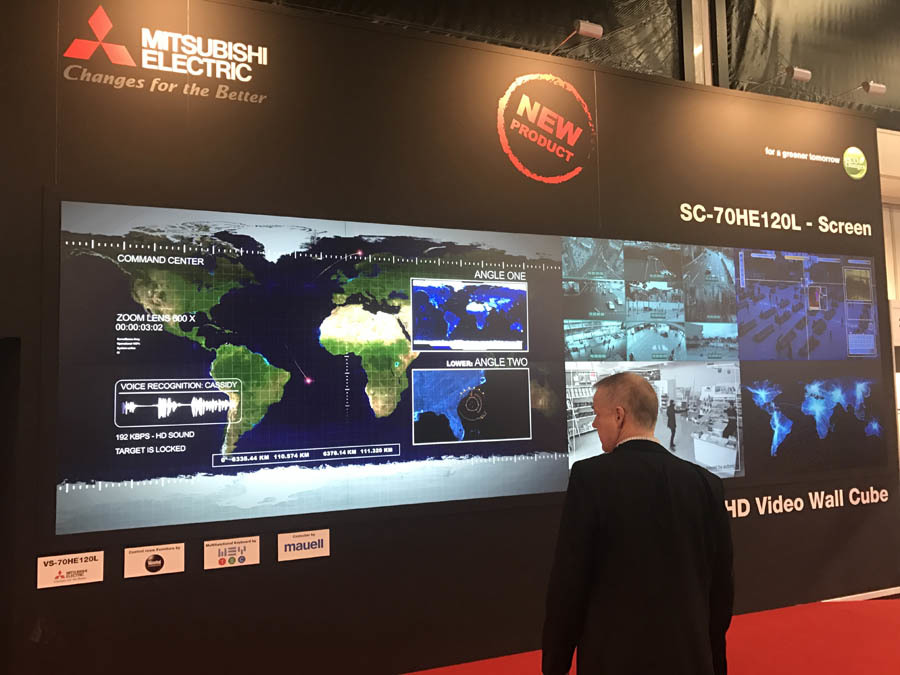
This year there were especially many curved surfaces, but they would not surprise anyone especially. The only important point - the surface of the projection screens allow you to clearly display the resolution of 8K on a fairly small linear dimensions.

If we talk about expensive solutions, Sony is noted here. They put a very large LED screen on the stand. It is remarkable in that it is covered with a glossy film and looks as if this is one big screen in its classic sense. Because of the film, pixels are not visible, crosslinks are not visible. At the distance of stitching between the modules is not visible, but near these boundaries are clearly visible. The film just closes the seams. The effect of one large surface is achieved. The range of application of such large screens is very wide. They can be used for various installations. When cheaper, it will be very useful to museums, various exhibition venues, shopping and entertainment centers in the design of space.

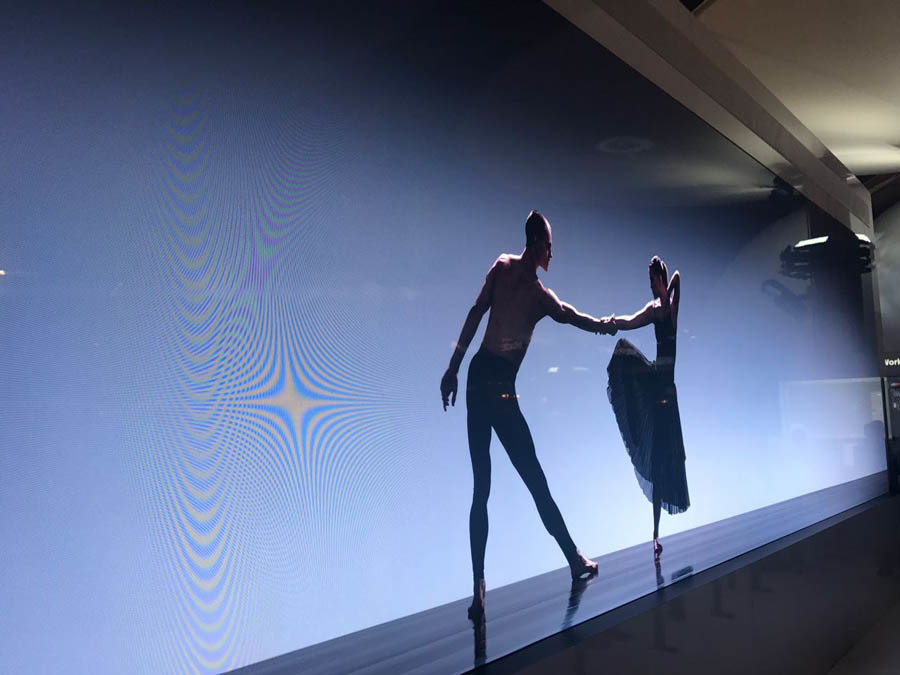
It is worth millions of dollars, but wow effect hoo!
Here is Barco's interesting solution, pay attention to the distance and location of the projectors:
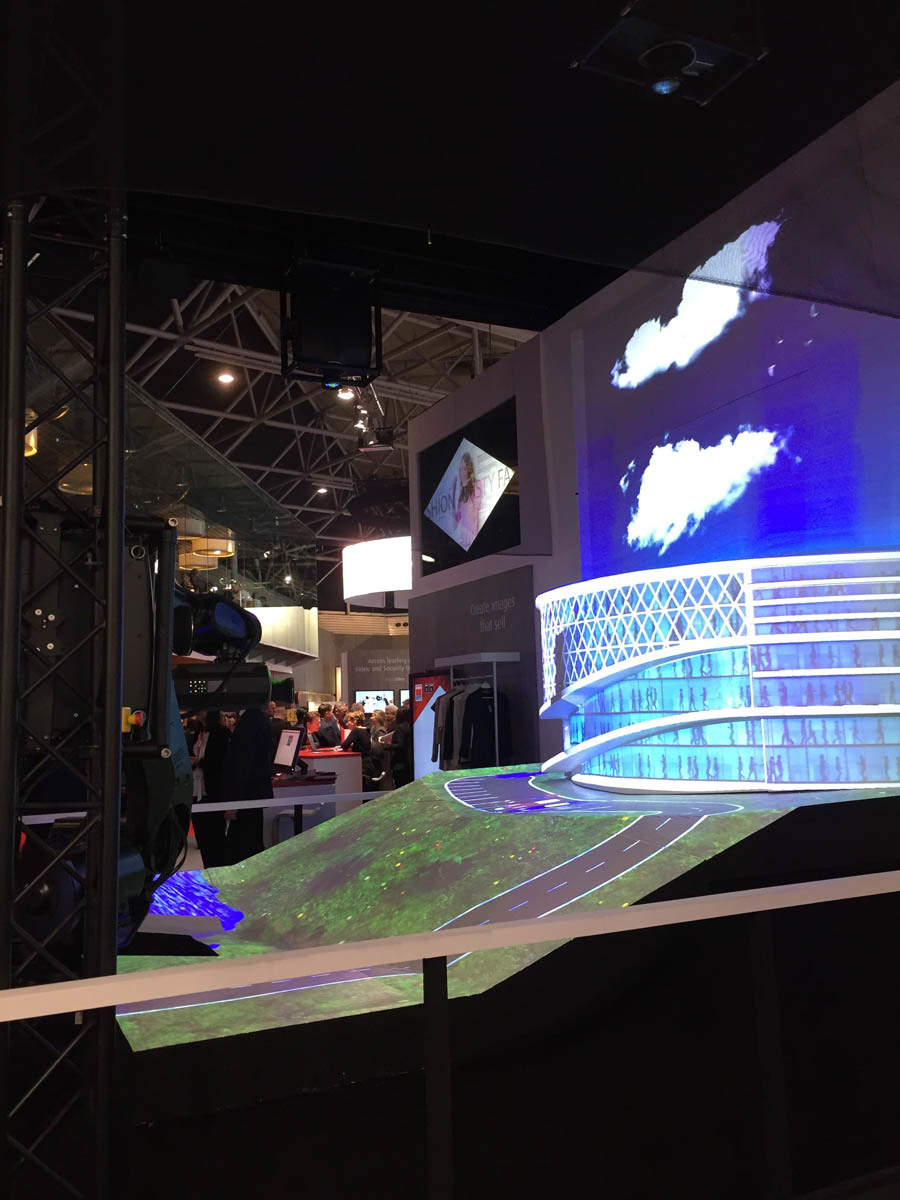
Projectors can be hung from different angles, and the content is combined into a single stitching. They themselves look at the initialization, how everything is connected, and correct the picture themselves .
Here is a car - a real car on the wall. It is completely white, its projectors are painted in the desired colors:
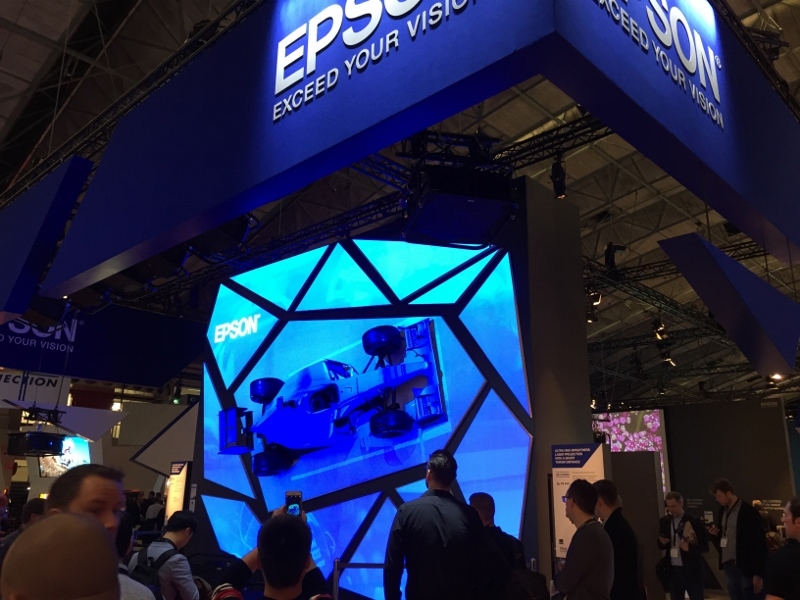
Christie has software that allows you to set up projectors in difficult conditions, for example, ice palaces, where projectors shine on the ice. Here it often happens that the setup of projectors (it is complicated, there is a stitching) gets off. The software allows you to quickly re-adjust the projectors, and it does not need to go into the equipment. Everything is done soft, moreover, it is automated (by pressing one button).

There were several new panoramic stitches. Very large panels - about human height. They are universal and relatively cheap - we will go to broadcast museum and exhibition content. By the way, there is a military museum in Tula, where a fighter (projection) appears in the middle of the exposition and starts to tell something, but he is very sensitive to daylight. With these panels it would be more realistic.
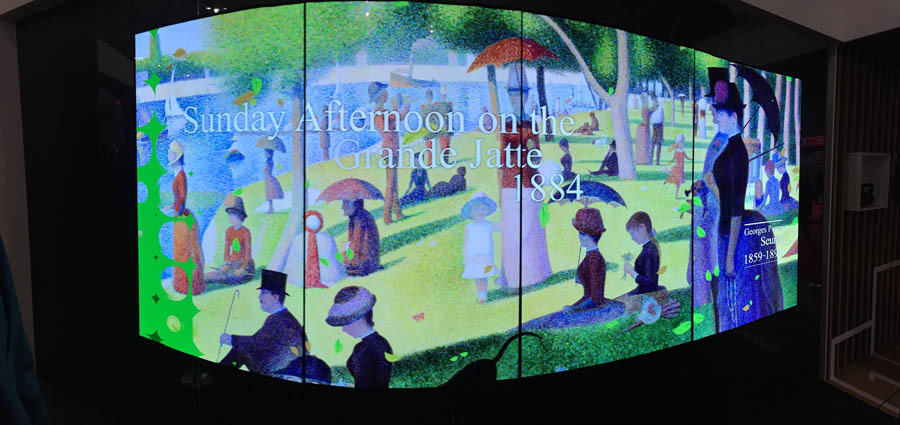
At the exhibition there were quite a few solutions for retail, in particular, the topic of Digital Signage was actively discussed. I will note that more and more technologies appear on the market that allow you to display advertising depending on gender and age. As they say, this is the future. In Russia, in comparison with Europe, such solutions, unfortunately, are not very common. Although the experience is undoubtedly there. Not so long ago, we implemented such a technology (I mean a demonstration of content depending on gender) for one large Russian bank. Also, by the way, they recently introduced Digital Signage at the stadium of FC Krasnodar. There, the information is shown to fans depending on the location of the screens (there are 350 of them there): VIP-box, gift shop, food court. Due to the possibility of demonstrating targeted advertising Digital Signage allows you to get additional income to the stadium.
Traditional LED equipment for the facades of buildings has hardly changed, but, apparently, there were many complaints about the difficulties with maintenance, so now you can even walk on surfaces.
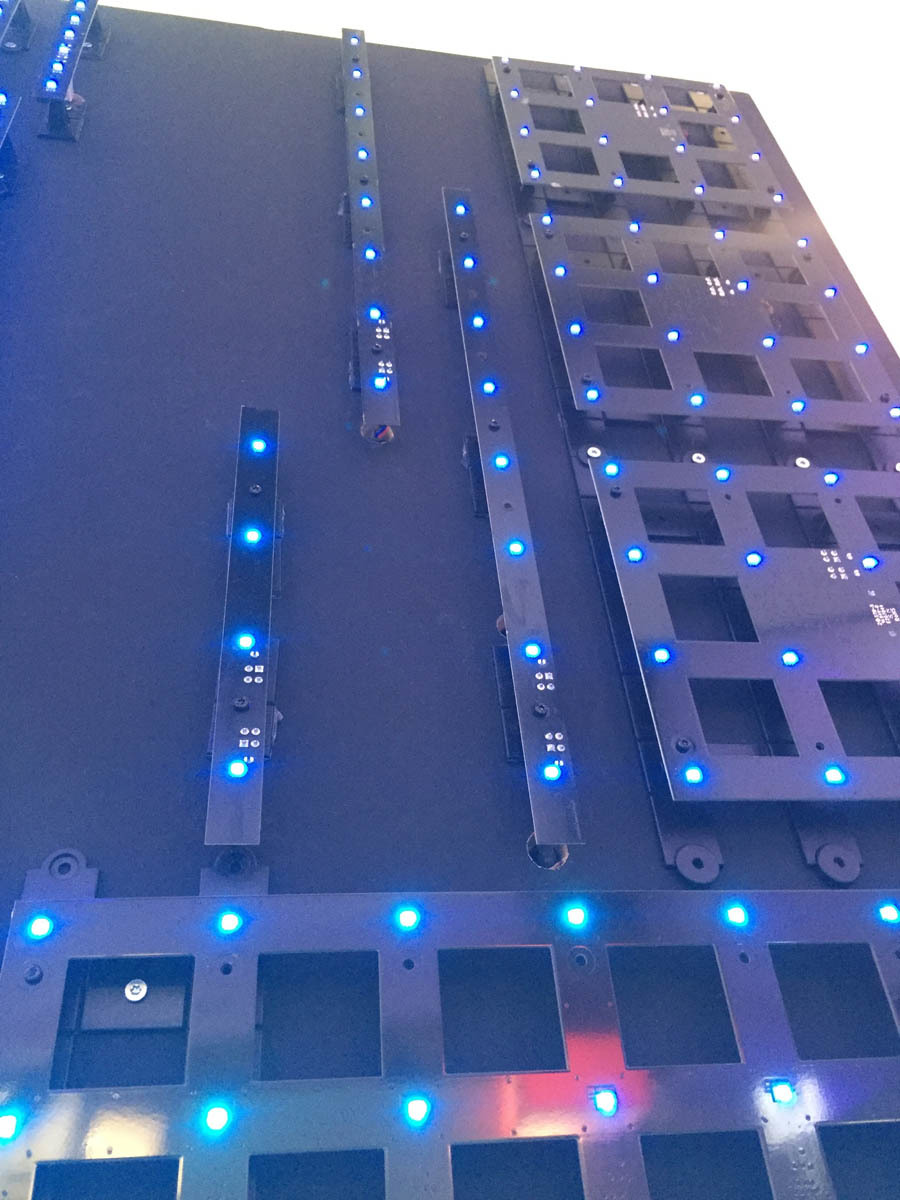

Also from the interesting - such a screen appeared on top of the LED: a canvas is hung with a certain degree of transparency. It removes some of the negative effects from the LED screen, which has a beneficial effect on vision. This would be useful for schools and institutions:

Useful feature - wireless charging for laptops and phones:
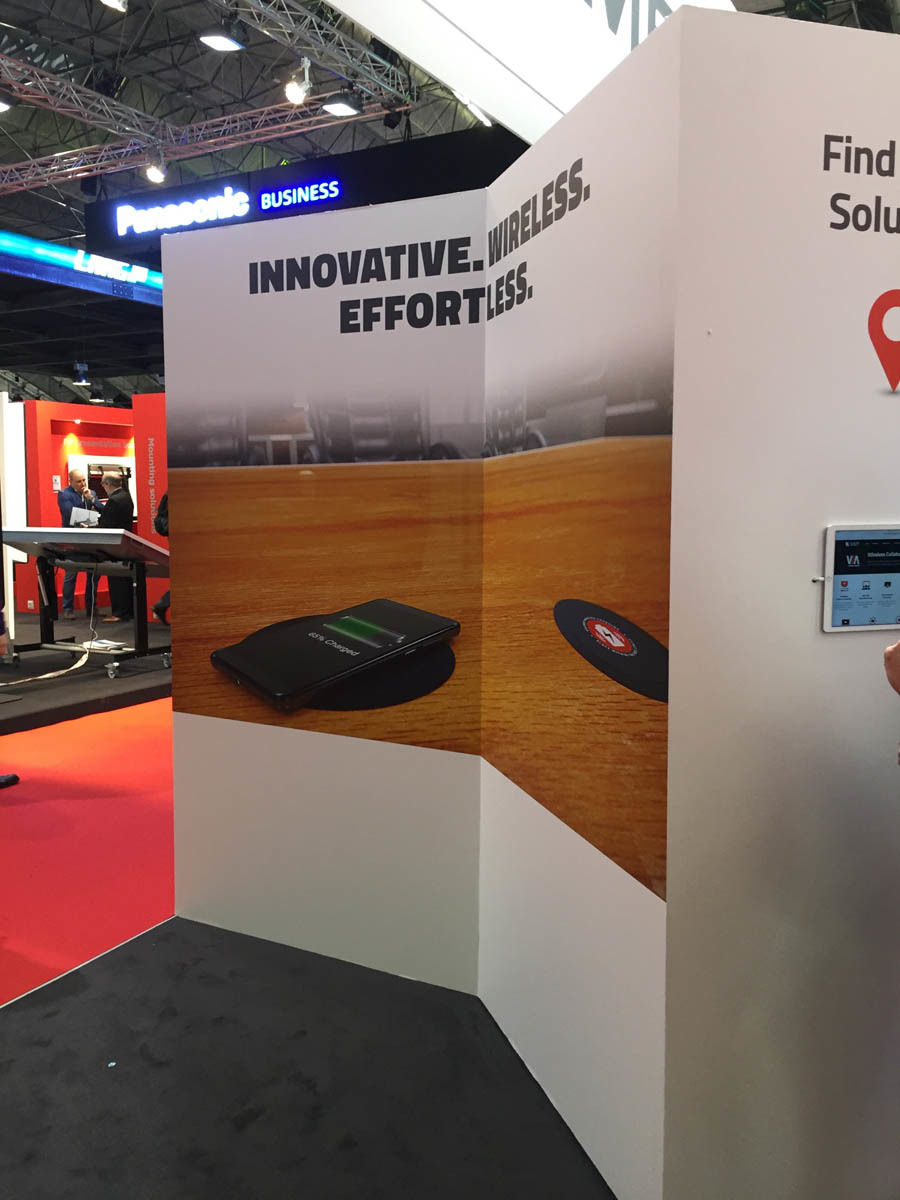
During the negotiations do not need to look for cables. If your phone supports wireless charging technology, you can simply relax and not worry that it will “sit down” at the wrong time. Well, do not be distracted from the discussion.
There was a lot of fashionable retail items that allow you to decorate any shop window and create a wow effect, for example:
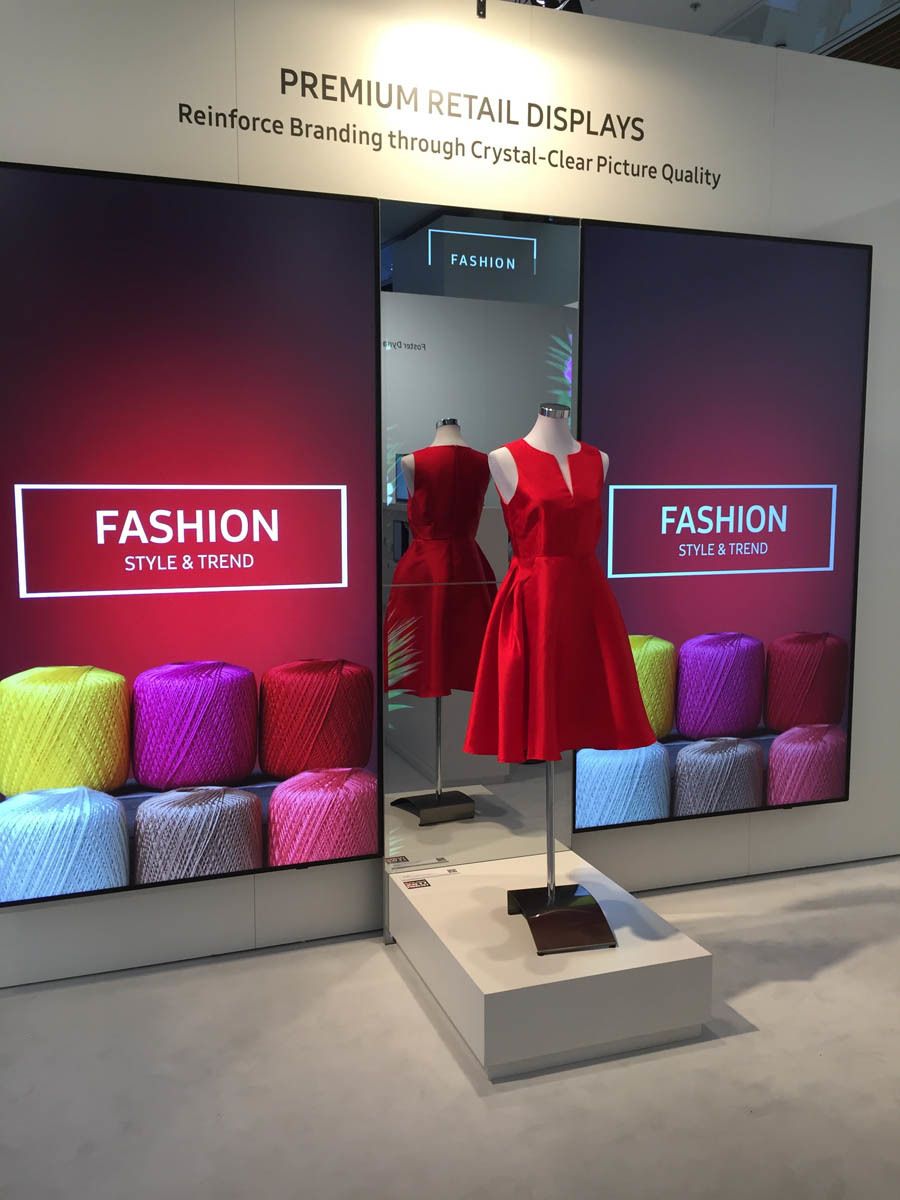
Interesting thing on LEDs:
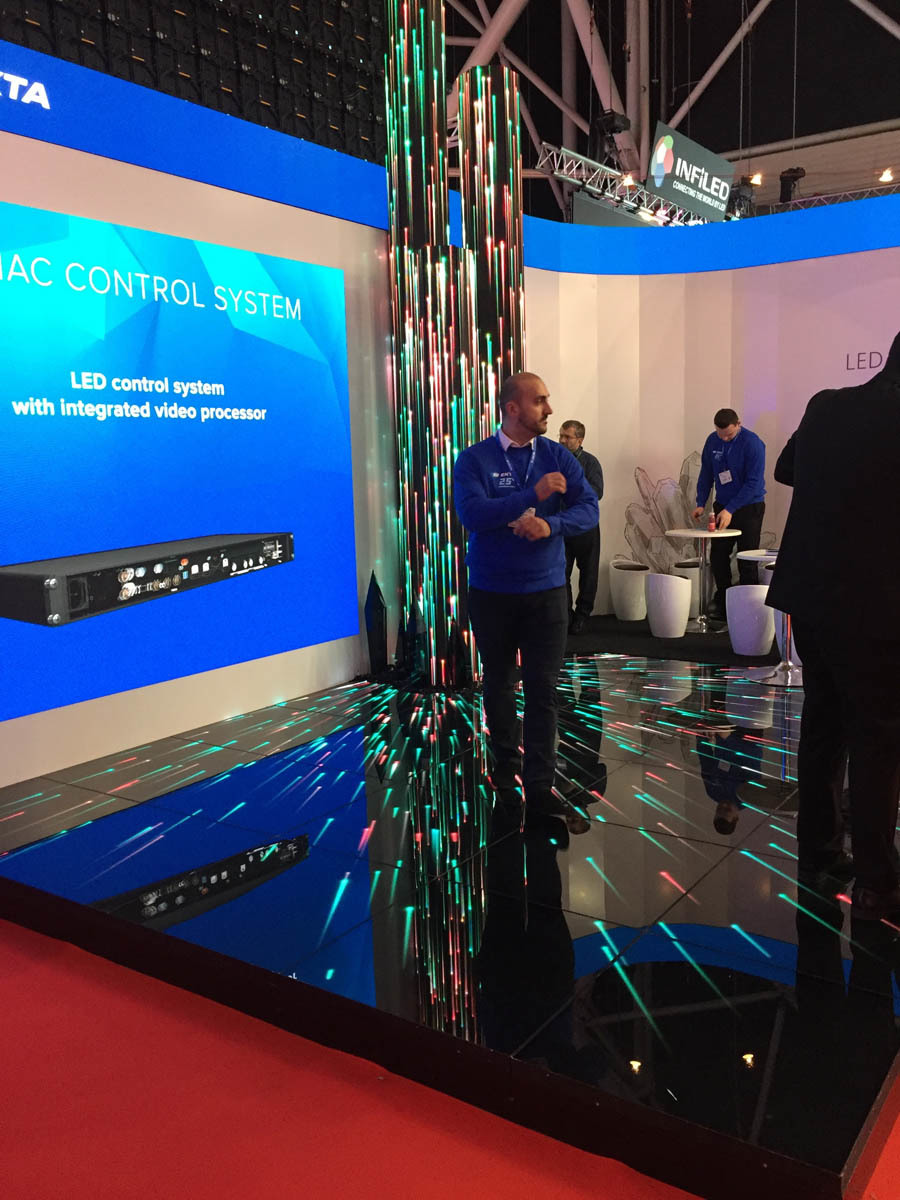
Content can be beaten on any surface, even on a pole) Again, it is useful to retaile to attract attention.
Screen Kicker:
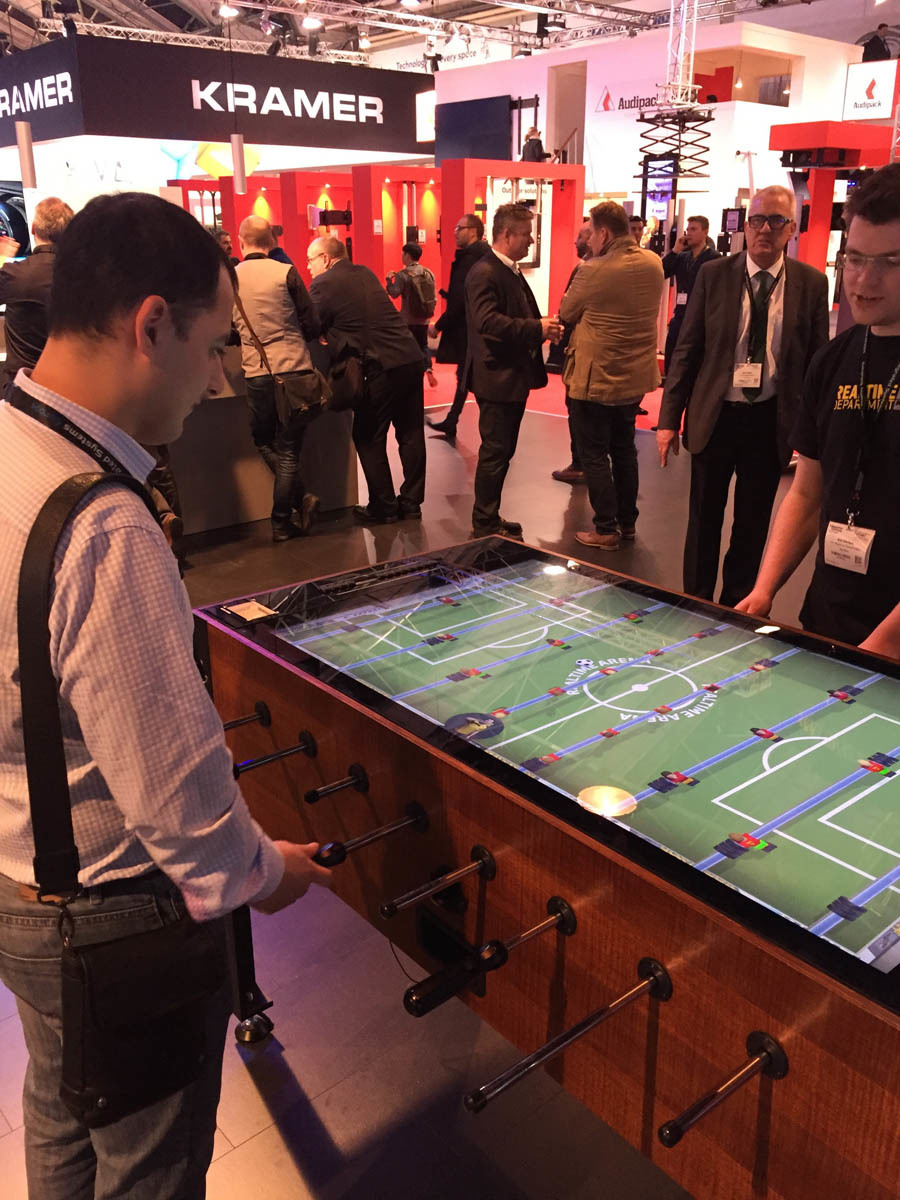
And finally - a stand where the guys grunt with the display:

They were probably just as upset as last year at the stand of flexible screens, when competitors arrived and broke the prototypes, bending them around the knee.


Two-way video wall (single screen) LG on OLED technology
Briefly about the most important thing:
')
1. LED screens are being improved, their production is cheaper. Accordingly, they are becoming more popular. The pixel pitch is already close to the psychological mark - 1 mm. Screens assembled from such modules have a juicy and bright picture at the level of top LCD panels. Technological processes for mass production of what was fiction 3-4 years ago, have already been honed and perfected. These screens can be used both for streets and for indoor use, for example, for information purposes. For retail they will also be useful, including external (front) advertising. Their advantage is brightness. With a certain technical performance, they are not afraid of weather conditions: neither sunlight, nor rain, nor cold.
2. Chinese manufacturers (in general, there are thousands of them, but LightLink, LightKing, Absen, Mignimage, Unilumin were remembered) tightly capture a multimedia niche. If, to my senses, before the exhibition was about 30% of the stands, now all 60%. From the breakthrough technology stage, we go to the butt stage, where engineers and developers are important. And there are more qualified engineers in China, thanks to their education system, which partially grew out of the Soviet one, than anywhere else.
3. Professional displays on OLED and QLED technologies are demonstrated.
4. There are many interesting software developments for the B2B sector.
This time, there was almost no unusual innovation at the exhibition, except for the closed area of the Samsung stand, where they showed screens on quantum dots.


LED screen of another Chinese manufacturer. Juicy picture and simple assembly - what else do you need for happiness?
Mapping
Each of the manufacturers competes not only in technology, but also in the entertainment of the exhibition stand. This year, Panasonic, the annual show-stopper, gave a great performance to attract attention. The manufacturer used a bundle: software for mapping and the formation of a single image with their projectors. If someone still doesn’t know what is probably incredible in our time, mapping is anchoring the image to objects and dynamically changing it in space in accordance with the movement of objects. This year, Panasonic screwed tracking of moving objects out of the box and superimposed on them the desired picture, taking into account all promising and geometric distortions. For the inexperienced, it looks like a miracle, but we have been doing similar tasks in our virtual reality center for several years now, so we simply admired the speed of work.
In general, there is software that processes content. Projectors transfer the image to a stitched concave screen. On the stand goes a man who holds a small board. He does some manipulations, and in accordance with his movements, the content also moves, while always remaining on the board. And there are balls that also move around the speaker. They also projected content during the move.
Easier to show than to explain)

Here is their cluster of projectors.
Of course, no one will tell what kind of software they used, but Christie and Catalyst have similar solutions. In general, the exhibition had a lot of solutions related to content management: various types of screens and sensors, readers. But they all have their own, without a single holistic standard. The task is to combine everything into a single system.
LEDs, LCD, OLED and quantum dots
This year, a noticeable change: a lot of LED screens of various types. Let me remind you that five years ago they were mainly used for outdoor advertising and were very expensive. Then they became weather-resistant, a little cheaper, they began to be used in indoor. Next, manufacturers have reduced the pixel pitch.
We see the final of the epic now - they are already in density, in my opinion, almost like LCD, but still much more expensive in terms of cost. The pixel pitch is smaller, which means such screens display content more accurately. If you place such a screen, for example, in a store, then in the commercial that is shown on it, you can look at everything to the smallest detail, even the texture of the fabric ... The images are more reliable.

LG Super Slim Screen

He is in turn

Two-way OLED-infotable
LG chose the OLED smartphones already familiar to us, and Samsung considered that the technological problems with the production of broad matrices are unworthy of attention, and immediately jumped onto a new technology - QLED, in other words, quantum dot displays. Here is a description of the technology .
Connections
Another trend is the simplification of screen connections. Previously, it was a real headache, but now the screens are interconnected very easily. Even a housewife can now assemble an unusual surface (I mean screens of irregular shape, disproportionate, with curved surfaces consisting of different parts). Well, at least, if she has only one higher technical, and not two, as before.

Here is just an example of an unusual surface - "blinds")

From individual screens you can even collect such
I was very pleased with the Mitsubishi stand - they made new cubes almost seamlessly. Previously, the seam was much larger than the pitch between the pixels, about 2 millimeters. Now there is less than one - it is very important for assembling large screens of control and situational centers. The fact is that they often show graphic materials with small elements (maps, engineering schemes, pipeline plans, nuclear station subsystems), and transmission without distortion is important there. Cubes are used because they are optimal for quickly understanding the situation, which is extremely important in emergency situations. LCD panels can give the same size of the assembly screen, but the seams will be larger. LED screens with a small pixel pitch are more expensive and are not yet as good in resolution. The result - most likely, such a wall will soon appear in our large control rooms:

This year there were especially many curved surfaces, but they would not surprise anyone especially. The only important point - the surface of the projection screens allow you to clearly display the resolution of 8K on a fairly small linear dimensions.

If we talk about expensive solutions, Sony is noted here. They put a very large LED screen on the stand. It is remarkable in that it is covered with a glossy film and looks as if this is one big screen in its classic sense. Because of the film, pixels are not visible, crosslinks are not visible. At the distance of stitching between the modules is not visible, but near these boundaries are clearly visible. The film just closes the seams. The effect of one large surface is achieved. The range of application of such large screens is very wide. They can be used for various installations. When cheaper, it will be very useful to museums, various exhibition venues, shopping and entertainment centers in the design of space.


It is worth millions of dollars, but wow effect hoo!
Projectors
Here is Barco's interesting solution, pay attention to the distance and location of the projectors:

Projectors can be hung from different angles, and the content is combined into a single stitching. They themselves look at the initialization, how everything is connected, and correct the picture themselves .
Here is a car - a real car on the wall. It is completely white, its projectors are painted in the desired colors:

Christie has software that allows you to set up projectors in difficult conditions, for example, ice palaces, where projectors shine on the ice. Here it often happens that the setup of projectors (it is complicated, there is a stitching) gets off. The software allows you to quickly re-adjust the projectors, and it does not need to go into the equipment. Everything is done soft, moreover, it is automated (by pressing one button).

There were several new panoramic stitches. Very large panels - about human height. They are universal and relatively cheap - we will go to broadcast museum and exhibition content. By the way, there is a military museum in Tula, where a fighter (projection) appears in the middle of the exposition and starts to tell something, but he is very sensitive to daylight. With these panels it would be more realistic.

miscellanea
At the exhibition there were quite a few solutions for retail, in particular, the topic of Digital Signage was actively discussed. I will note that more and more technologies appear on the market that allow you to display advertising depending on gender and age. As they say, this is the future. In Russia, in comparison with Europe, such solutions, unfortunately, are not very common. Although the experience is undoubtedly there. Not so long ago, we implemented such a technology (I mean a demonstration of content depending on gender) for one large Russian bank. Also, by the way, they recently introduced Digital Signage at the stadium of FC Krasnodar. There, the information is shown to fans depending on the location of the screens (there are 350 of them there): VIP-box, gift shop, food court. Due to the possibility of demonstrating targeted advertising Digital Signage allows you to get additional income to the stadium.
Traditional LED equipment for the facades of buildings has hardly changed, but, apparently, there were many complaints about the difficulties with maintenance, so now you can even walk on surfaces.


Also from the interesting - such a screen appeared on top of the LED: a canvas is hung with a certain degree of transparency. It removes some of the negative effects from the LED screen, which has a beneficial effect on vision. This would be useful for schools and institutions:

Useful feature - wireless charging for laptops and phones:

During the negotiations do not need to look for cables. If your phone supports wireless charging technology, you can simply relax and not worry that it will “sit down” at the wrong time. Well, do not be distracted from the discussion.
There was a lot of fashionable retail items that allow you to decorate any shop window and create a wow effect, for example:

Interesting thing on LEDs:

Content can be beaten on any surface, even on a pole) Again, it is useful to retaile to attract attention.
Screen Kicker:

And finally - a stand where the guys grunt with the display:

They were probably just as upset as last year at the stand of flexible screens, when competitors arrived and broke the prototypes, bending them around the knee.
Source: https://habr.com/ru/post/323852/
All Articles